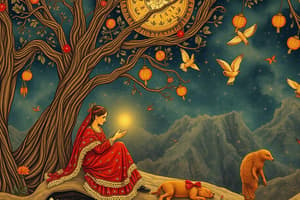Podcast
Questions and Answers
Which characteristic describes the Native American oral traditions?
Which characteristic describes the Native American oral traditions?
- Separation of sacred and secular aspects
- Teach moral lessons and convey practical information (correct)
- Rely on written texts and documentation
- Focus on individual success and achievements
What subject matter is commonly associated with European writings about Native Americans?
What subject matter is commonly associated with European writings about Native Americans?
- Political theories
- Philosophical essays on ethics
- Mythical tales of heroes
- Exploration and struggles with Native Americans (correct)
Which key figure is noted for being the first published poet in the New World?
Which key figure is noted for being the first published poet in the New World?
- Ralph Waldo Emerson
- Anne Bradstreet (correct)
- Edward Taylor
- Phillis Wheatly
What philosophical approach characterized the Age of Reason and Revolution?
What philosophical approach characterized the Age of Reason and Revolution?
Which author is associated with dark romanticism?
Which author is associated with dark romanticism?
What concept is central to transcendentalism?
What concept is central to transcendentalism?
Which of the following was NOT a subject matter of early American literature?
Which of the following was NOT a subject matter of early American literature?
Which literary characteristic is associated with romanticism?
Which literary characteristic is associated with romanticism?
Flashcards
Native American Oral Traditions
Native American Oral Traditions
Native American literature, passed down orally, including stories, songs, and chants.
Creation Myths
Creation Myths
Stories that explain the origin of the world, often featuring supernatural beings or events.
Characteristics of Native American Literature
Characteristics of Native American Literature
Literature that highlights respect for nature, interconnectedness between humans, animals, and the natural world, and emphasizes community over individualism.
Subject Matter of Puritan Colonial Literature
Subject Matter of Puritan Colonial Literature
Signup and view all the flashcards
Age of Reason
Age of Reason
Signup and view all the flashcards
American Romanticism
American Romanticism
Signup and view all the flashcards
Transcendentalism
Transcendentalism
Signup and view all the flashcards
Dark Romanticism
Dark Romanticism
Signup and view all the flashcards
Study Notes
Pre-Settlement to 1620
- Native American oral traditions existed, including myths, songs, chants, poems, and hero legends/trickster tales.
- These traditions conveyed moral lessons, cultural information, and practical knowledge about the natural world.
- A harmonious worldview, connecting humans, animals, and plants, characterized their perspective, emphasizing respect for nature, community, and the interconnectedness of all living things.
- The sacred and secular were not divided.
- European accounts (journals, letters, essays, logs, reports, maps) documented exploration, survival, fortune hunting, and interactions with Native Americans.
- Key figures to know include those involved in the accounts of exploration and the interactions with Native Americans. Works authored during this era like King Phillip's speech. Columbus letters and John Smith.
Puritanism + Colonialism (1620-1750)
- Early American literature focused on settlement concerns, hardships, daily life, and religious themes.
- The Enlightenment, emphasizing scientific inquiry, natural rights, and reason, became prevalent.
- Key figures include Anne Bradstreet (first published female poet in the New World) and Edward Taylor.
Age of Reason and Revolution (1750-1820)
- This era emphasized ideals of freedom and human potential alongside rational thought and logic.
- Truth was sought through reason, science, philosophy, and logic (Neoclassicism).
- Key characteristics included reason, scientific argument, wit, and neoclassicism (influenced by ancient Greek ideals).
- Types included political documents, philosophical writings, and structured poetry.
- Key figures include Phillis Wheatley and Washington Irving (a transitional figure towards Romanticism).
American Renaissance (1830-1870, Romanticism)
- Romanticism emphasized the beauty of nature, the supernatural, emotion over reason, and individual expression.
- Edgar Allan Poe and Nathaniel Hawthorne (dark romanticism) explored the supernatural.
- Walt Whitman exemplified straightforward romanticism.
- Key characteristics of Romanticism include intense appreciation of nature's beauty, reliance on emotion over reason for inspiration, and the prioritization of strong individual expression.
Transcendentalism (1830s-1850s)
- An offshoot of Romanticism, Transcendentalism emphasized the unity of creation, individualism, and self-reliance.
- Key figures include Ralph Waldo Emerson, known for his writings on nature.
- Emily Dickinson exemplified this through reimagined poetry, hymn-like themes, and was influenced by transcendentalism.
Studying That Suits You
Use AI to generate personalized quizzes and flashcards to suit your learning preferences.




